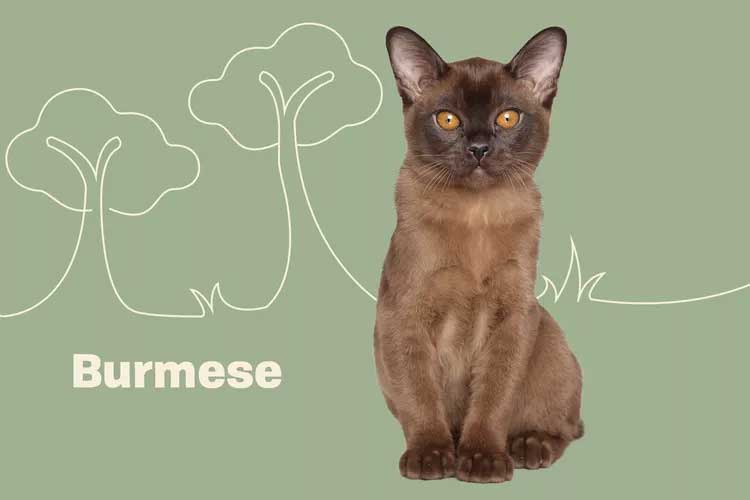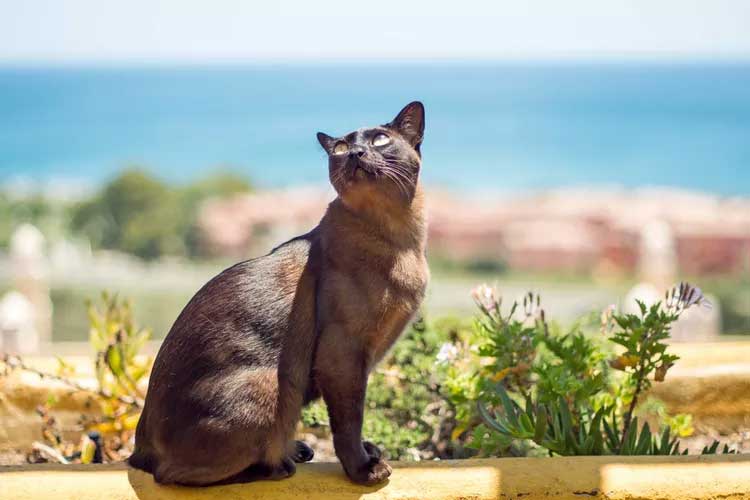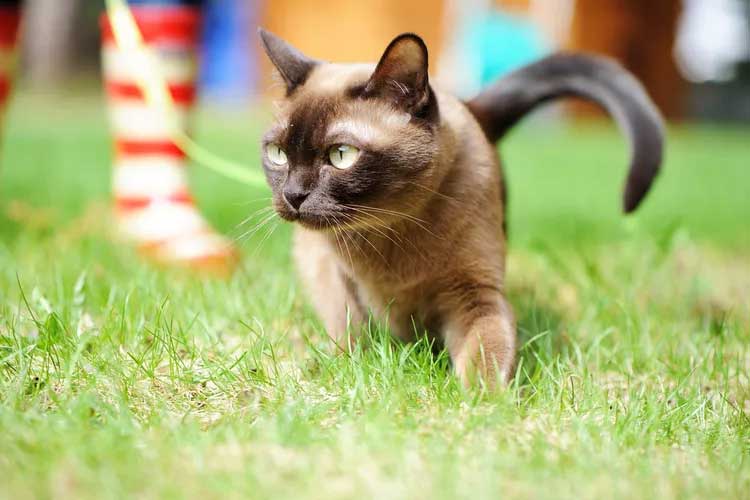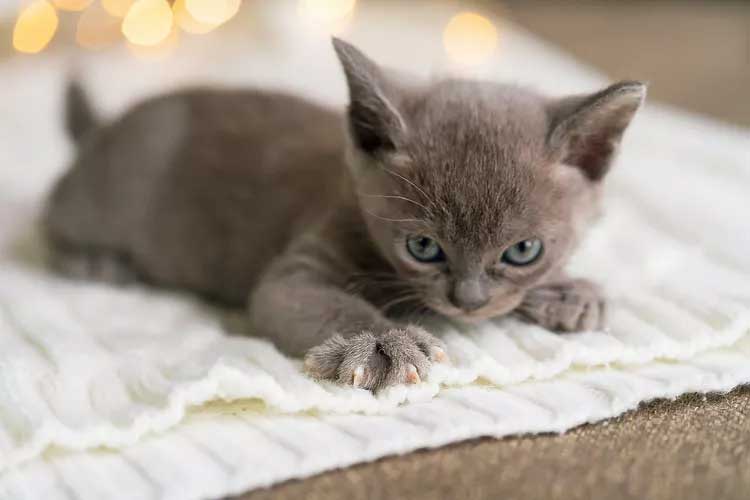With their huge eyes, outgoing personalities, and dog-like tendencies, Burmese are the perfect cat for winning over people who say they don’t like cats.

Burmese Overview
| OFFICIAL NAME | Burmese |
| COMMON NAME | Burmese |
| PET HEIGHT | 9 to 13 inches |
| PET WEIGHT | 8 to 15 pounds |
| LIFESPAN | 10 to 17 years |
| GOOD WITH | cats, children, dogs, families, seniors |
| TEMPERAMENT | affectionate, sociable |
| INTELLIGENCE | high |
| SHEDDING AMOUNT | seasonal |
| PLAYFULNESS | high |
| ENERGY LEVEL | active |
| VOCAL LEVEL | frequent |
| COAT LENGTH | short |
| COLORS | blue / gray, chocolate / brown / sable, lavender / silver, lilac |
| OTHER TRAITS | easy to groom, friendly toward humans, friendly toward other pets, friendly toward strangers, good for first-time pet owners, strong loyalty tendencies, tolerates being picked up |
It's really hard not to immediately like Burmese cats. Intelligent, playful little dynamos, Burmese are incredibly social to humans and will quickly learn to play interactive games like fetch or tag. They also make excellent ambassadors for any self-professed "non-cat people," thanks to their affectionate, almost dog-like personalities and their giant, expressive eyes that make Burmese cats look like they were ripped straight out of a Margaret Keane painting.
Appearance
So this is going to differ slightly, depending on where you live. There are, in point of fact, two Burmese cats. Though they originated from the same stock and most cat registries don't consider them to be genetically different breeds, there are still distinct differences between the American Burmese and the European Burmese.The European (sometimes called "traditional") Burmese is the more slender of the two, with a wedge-shaped head, small, pointed ears, and almond-shaped eyes. Meanwhile, the American (or "contemporary") Burmese is notably stockier with a wider head, ears that are slightly wider at the base than the European, and with eyes that are much rounder and more expressive.

Regardless of standard, all Burmese cats come with very short, silky coats, traditionally of a single, solid color. Originally, all Burmese were sable, but throughout the middle of the 20th century, Burmese cats were seen in colors such as fawn, blue, and lilac. Currently, the British standard recognizes solid brown, chocolate, blue, lilac, red, and cream, as well as the tortoiseshell pattern on a base of brown, chocolate, blue, or lilac, while the Cat Fanciers' Association's (CFA) standard still recognizes the Burmese only in solid sable, blue, champagne (chocolate), and platinum (lilac).
Temperament
Burmese cats are loving, playful, and highly social. Expressing a number of tendencies that have been described as "dog-like," Burmese tend to develop strong loyalty bonds with their humans and have been described as a "Velcro cat," wanting to spend as much time as possible around their people. As such, Burmese aren't as well suited to isolation as some other breeds, and may develop stress behaviors such as aggressive grooming if left alone for extended periods of time.Burmese revel in the company of humans, be they seniors, children, or somewhere in between. They also do extremely well in multi-cat households and can even fairly quickly learn to (at very least) tolerate the family dog.

Burmese are very bright cats and enjoy performing for their people. Owners have reported having their Burmese stop in the middle of some spirited play to look back and see if their humans are watching them before continuing. Additionally, they are more heavily disposed to playing games with their people than many other breeds, quickly picking up the nuances of fetch, tag, hide and seek, and other games.
Additionally, if cat shows are your thing, Burmese cats are well recognized for their willingness to be shown. They enjoy being the center of attention and like performing for a crowd.
One potential caveat for owners: the Burmese is not a quiet cat. True to the Siamese traces in their lineage, the Burmese is always more than happy to talk you through their day, though they have a softer, less intense voice than their Siamese cousins.
Living Needs
Whether they are playing or just sitting on the couch, the biggest factor in having a happy Burmese is going to be proximity to you. They develop loyalty bonds quickly and want to be wherever you are. If your lap is empty, your Burmese will happily climb into it to snooze, says M. Leanne Lilly, DVM, DACVB, assistant professor-clinical at the Ohio State University Veterinary Medical Center.Along with your lap, Lilly also says Burmese cats are more likely to favor sleeping in warm, elevated areas. So if you bring home a Burmese kitten, make sure you have a cat tree and a hammock for her to curl up in. But don't expect this breed to spend all her time asleep.
"Data suggests Burmese coat-patterned cats are more playful," Lilly says. "And the breed overall [tends] to be more likely to have prey interest."

Cat toys that mimic mice and birds will make your Burmese purr. You'll also frequently catch her in a sunny spot, chattering out the window at passing wildlife.
They should, under no circumstances, be allowed to venture outside on their own. Because Burmese cats love their people so much, they're virtually lost without them. If your kitty tries to dart out the front door every time you open it, try taking her out on a harness or building a catio so she can—safely—enjoy the outdoors.
Care
Their super short coats and relative lack of shedding make the Burmese a breeze to groom. Brushing and bathing should be virtually nonexistent, save for a little combing during traditional shedding seasons in the spring and fall, but even those times should be fairly light.Like all cats, you need to trim her nails regularly and keep her litter box clean. Keep up with regular veterinarian appointments to keep her in tip-top shape, too.
Health
Burmese are a fairly healthy breed, though, like with all cats, there are certain health conditions owners should be aware of.Burmese are at an increased risky of diabetes mellitus than most breeds, Lilly says. They can also be susceptible to feline orofacial pain syndrome and genetic hypokalemia, which is a condition connected to a low potassium level in the blood serum. In many cases, these conditions and several others can be helped through diet.
"There are veterinary food companies that have veterinary nutritionists who formulate prescription diets, specifically for a given disease," says Michelle Beck, DVM, CCRT, CVA, of the Backlund Animal Clinic in Omaha, Neb. "For diabetic cats, for example, higher protein diets work well. Cats with chronic kidney disease, we've found that giving cats a diet with a high quality but low percentage of protein works well."

The Burmese Breed Council has also recently started allowing outcrossing with Bombay and Tonkinese cats in an effort to build up the Burmese breed's genetic diversity. A 2008 study found the American Burmese to be one of the least genetically diverse breeds in the world, Lilly says, and in 2012 the CFA stated that "breeders are reporting less hearty litters, smaller adults, smaller litters, and immune system problems, all of which point towards inbreeding depression becoming more common."
History
The Burmese as we know and love her today can trace her entire lineage back to a single cat: a brown female named Wong Mau who was imported to San Francisco from Burma in 1930. According to the Burmese Cat Club, Wong Mau was bred with Tai Mau, a seal point Siamese, then bred back to the males of that litter, and the Burmese breed was off and running.The CFA recognized the breed in 1936 but, in a rare move, actually suspended the breed's recognition in 1946 due to extensive outcrossing with Siamese in an effort to increase the breed's numbers. After breeders were able to report three successive generations of pure Burmese litters, the breed's recognition was restored in 1954.
Meanwhile, the European Burmese was being developed throughout the 1940s, mostly through crossbreeding Tonkinese, Siamese, and a few American Burmese who had been imported. By 1952, the breed had been sufficiently established to gain recognition from the United Kingdom's Governing Council of the Cat Fancy, and today most European and Commonwealth countries raise Burmese to the British standard.
Fun Facts
Thanks to their stout builds, Burmese cats are well-known for being heavier than they look. In descriptions, they are often referred to as "bricks wrapped in silk."The ancestors of the Burmese originated in Thailand, where they were kept in monasteries.